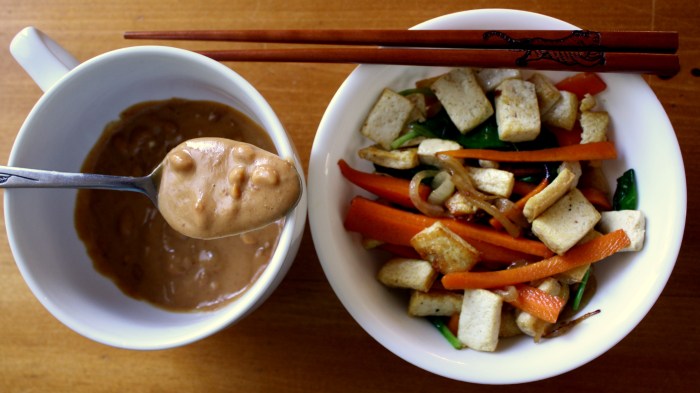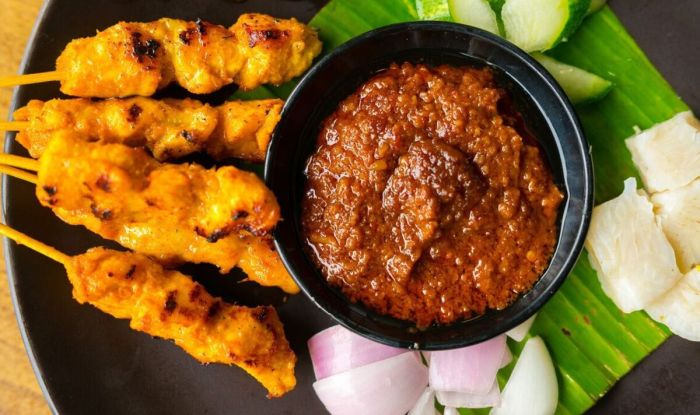Basic Satay Sauce: A Culinary Exploration: Basic Satay Sauce Recipe
Basic satay sauce recipe – Satay sauce, a cornerstone of Southeast Asian cuisine, is a rich and flavorful condiment primarily characterized by its peanut base. Its origins trace back to Indonesia and Malaysia, where it’s an integral part of the beloved satay dish – grilled marinated meat skewers. However, its versatility extends far beyond this traditional application, finding its way into numerous dishes across various culinary traditions.
Introduction to Basic Satay Sauce

Source: braisedanatomy.com
Satay sauce is a creamy, savory sauce made primarily from peanuts, typically blended into a smooth paste. Its origins lie in the Indonesian archipelago, evolving alongside the satay grilling tradition. The sauce’s cultural significance stems from its association with communal gatherings and festive occasions. It’s a versatile condiment, enhancing the flavors of various meats, vegetables, and noodles, not only in Southeast Asian cuisine but also finding its place in fusion dishes worldwide.
Essential Ingredients of Basic Satay Sauce
A basic satay sauce recipe relies on a few key ingredients that work together to create its distinctive flavor profile. The careful selection and proportioning of these ingredients are crucial to achieving the desired taste and texture.
The core ingredients typically include peanut butter (smooth or crunchy), soy sauce, palm sugar or brown sugar, lime juice, and garlic. Peanut butter provides the creamy base and characteristic nutty flavor. Soy sauce adds saltiness and umami depth. Palm sugar or brown sugar contributes sweetness and balances the savory elements. Lime juice provides acidity, cutting through the richness of the peanut butter.
Finally, garlic adds a pungent aroma and flavor.
Different types of peanut butter offer varying flavor profiles and textures, impacting the final satay sauce. The choice of peanut butter significantly influences the overall sensory experience.
| Peanut Butter Type | Flavor Profile | Texture | Recommended Use in Satay Sauce |
|---|---|---|---|
| Smooth Peanut Butter | Mildly sweet, creamy, nutty | Smooth and creamy | Ideal for a classic, smooth satay sauce |
| Crunchy Peanut Butter | More intense nutty flavor, slightly sweet | Slightly chunky with peanut pieces | Adds texture and a more pronounced nutty flavor |
| Natural Peanut Butter (no added sugar) | Stronger peanut flavor, less sweet | Can be slightly oily | Provides a more intense peanut flavor, requires adjustment of sweetener |
| Roasted Peanut Butter | Rich, deep roasted peanut flavor | Smooth or slightly chunky | Adds a complex and smoky dimension to the sauce |
Step-by-Step Recipe for Basic Satay Sauce
This recipe provides a foundational base that can be easily customized to individual preferences. Adjusting the amount of chili paste or adding other spices allows for variations in spice levels.
- In a saucepan, whisk together peanut butter, soy sauce, palm sugar, lime juice, and garlic.
- Add water gradually, whisking constantly until the sauce reaches your desired consistency. Start with a small amount of water and add more as needed.
- Simmer over low heat for 5-7 minutes, stirring frequently, to allow the flavors to meld and the sauce to thicken slightly.
- Stir in chili paste (optional) to adjust the level of spiciness.
- Taste and adjust seasoning as needed. You may want to add more lime juice for acidity, sugar for sweetness, or soy sauce for saltiness.
- Remove from heat and let cool slightly before serving.
Variations and Adaptations of Basic Satay Sauce
The basic satay sauce recipe serves as a springboard for creativity. Numerous variations exist, catering to diverse palates and dietary needs.
Sweet satay sauce can be achieved by increasing the amount of palm sugar. For a spicier version, add more chili paste or other chili-based ingredients like sambal oelek. A creamier texture can be obtained by using full-fat coconut milk or adding a touch of heavy cream. Vegan versions can be made by ensuring all ingredients are plant-based.
Gluten-free versions can be made by using tamari or coconut aminos instead of soy sauce.
Serving Suggestions and Culinary Applications

Source: co.uk
Satay sauce’s versatility extends beyond traditional satay. Its rich flavor profile complements a wide range of dishes.
- Grilled meats (chicken, beef, pork, lamb)
- Vegetables (broccoli, cauliflower, carrots)
- Noodles (udon, soba, rice noodles)
- Spring rolls
- Dumplings
- As a dipping sauce for various appetizers
Visual Representation of Satay Sauce, Basic satay sauce recipe
The ideal satay sauce boasts a rich, deep brown color, reflecting the nutty tones of the peanut butter. Its texture should be smooth and creamy, with a slightly glossy sheen. The visual appeal is enhanced when served alongside vibrant-colored dishes, creating a pleasing contrast and highlighting the sauce’s richness.
The sauce’s depth is evident in its rich brown hue, subtly shifting in tone depending on the lighting. When drizzled over food, it creates a visually appealing cascade, coating the dish with its glossy surface and emphasizing its creamy texture.
Storage and Shelf Life of Satay Sauce
Proper storage is crucial for maintaining the quality and extending the shelf life of homemade satay sauce.
Store leftover satay sauce in an airtight container in the refrigerator. It will typically last for 3-5 days. For longer storage, freezing is recommended. Freeze the sauce in airtight containers or freezer bags, and it can last for up to 3 months. To extend the shelf life, ensure the sauce is completely cooled before storing and avoid repeated freezing and thawing.
Commonly Asked Questions
Can I use smooth peanut butter instead of crunchy?
Absolutely! Smooth peanut butter will create a smoother, creamier sauce. Crunchy peanut butter adds texture but might not be suitable for all applications.
How long will homemade satay sauce last in the refrigerator?
Properly stored in an airtight container in the refrigerator, homemade satay sauce should last for about 5-7 days.
Can I freeze satay sauce?
Yes, you can freeze satay sauce. Allow it to cool completely before transferring it to a freezer-safe container. It should last for 2-3 months in the freezer.
What can I do if my satay sauce is too thick?
A basic satay sauce recipe typically involves blending peanuts, spices, and a touch of sweetness. For a completely different flavor profile, consider exploring a richer, sharper taste by consulting a recipe for a different type of sauce, such as this asiago sauce recipe , which offers a fascinating contrast in texture and taste. Then, you can appreciate the simplicity and unique qualities of your basic satay sauce even more.
Thin it out with a little water, coconut milk, or even lime juice, a teaspoon at a time, until you reach your desired consistency.
What can I do if my satay sauce is too thin?
Simmer the sauce gently for a few minutes to reduce the liquid and thicken it. You can also add a teaspoon of cornstarch mixed with a little water to help thicken the sauce.
